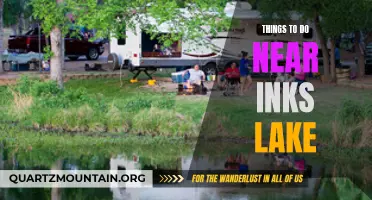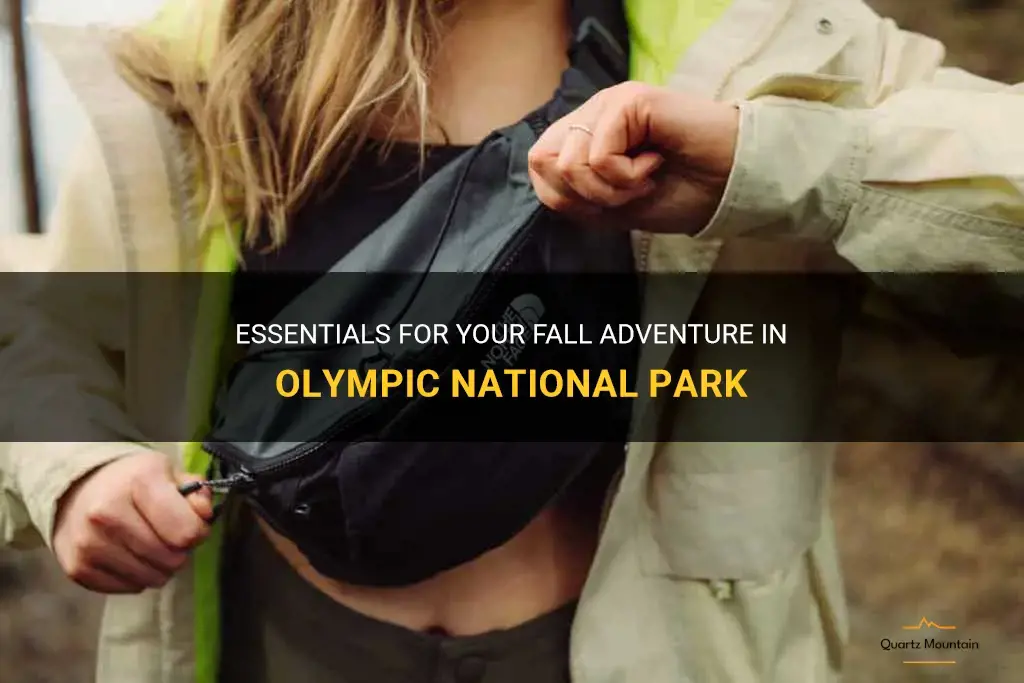
As the leaves turn vibrant hues and the crisp autumn air sets in, there's no better time to embark on a fall adventure in Olympic National Park. Nestled in the picturesque Pacific Northwest, this diverse and sprawling wilderness offers a myriad of opportunities for outdoor enthusiasts to explore. From breathtaking hiking trails and roaring waterfalls to serene campgrounds and abundant wildlife, the park is a haven of natural wonders. To ensure you make the most out of your fall escapade, it's essential to pack the right equipment and gear. So, lace up your boots, grab your backpack, and get ready to discover the essentials for your unforgettable autumn journey in Olympic National Park.
What You'll Learn
- What are the essential items to pack for a fall visit to Olympic National Park?
- What clothing should I bring for the varying weather conditions in Olympic National Park during the fall?
- Are there any specific hiking gear or equipment I should pack for exploring Olympic National Park in the fall?
- What type of footwear is recommended for hiking on the trails in Olympic National Park during the fall season?
- Are there any specific items or gear that are must-haves for photography enthusiasts visiting Olympic National Park in the fall?

What are the essential items to pack for a fall visit to Olympic National Park?
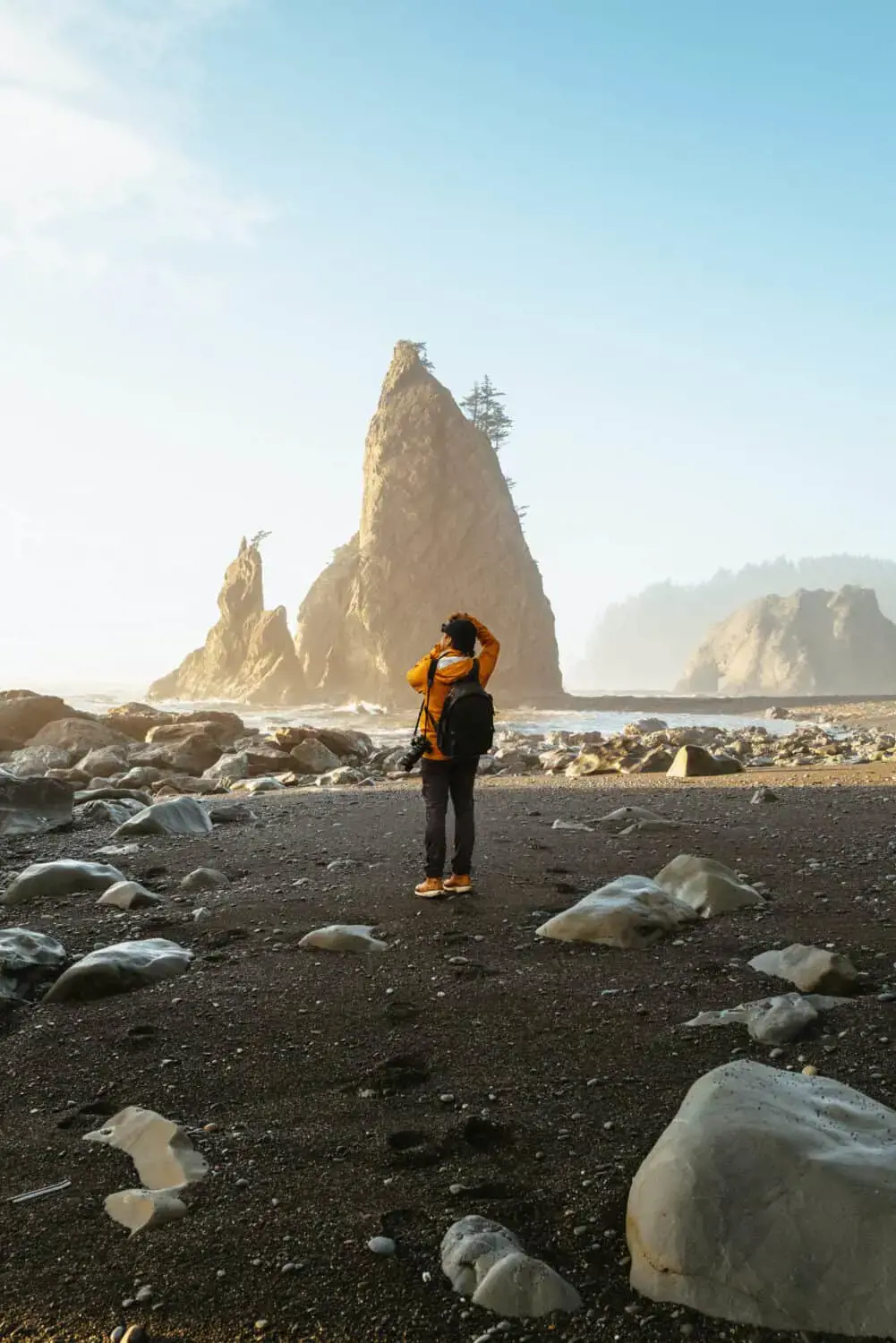
Are you planning a visit to Olympic National Park this fall? As the seasons change, so do the essential items you need to pack for your outdoor adventure. Here are some key items to consider when preparing for a fall visit to Olympic National Park:
- Layered Clothing - Fall weather can be unpredictable, with changing temperatures throughout the day. It is important to pack a variety of clothing items that you can layer to adjust to the temperature changes. Start with a moisture-wicking base layer, followed by a warm insulating layer and a waterproof and windproof outer layer.
- Waterproof Gear - Rain is common in the Pacific Northwest, even in the fall. Make sure to pack a waterproof jacket and pants to keep you dry during your outdoor activities. Additionally, consider waterproofing your boots or bringing a pair of waterproof hiking shoes.
- Warm Accessories - As the temperatures drop, it's essential to pack warm accessories such as hats, gloves, and scarves. These items will keep you comfortable and protected from the cold weather, especially in higher elevations or during early morning and evening hikes.
- Sturdy Footwear - Olympic National Park offers a variety of trails, ranging from easy strolls to challenging hikes. Regardless of the difficulty level, it is important to have sturdy and comfortable footwear to support your feet and provide traction on different terrains. Make sure your shoes are broken-in before your visit to prevent blisters and discomfort.
- Navigation Tools - Olympic National Park is vast and offers a multitude of trails and scenic spots. It is essential to bring navigation tools such as a topographic map, compass, or GPS device to help you navigate the park's vast wilderness. Familiarize yourself with the area and plan your routes before setting off on your adventure.
- First Aid Kit - Accidents can happen during outdoor activities. Packing a basic first aid kit is crucial to address minor injuries and provide necessary medical attention until help arrives. Include items such as band-aids, gauze pads, adhesive tape, antiseptic wipes, and any personal medications you may need.
- Food and Water - It's important to stay hydrated and nourished during your outdoor adventure. Pack enough water to last the duration of your trip, as well as high-energy snacks or lightweight meals that are easy to prepare and consume on the go. Remember to pack a way to purify water from natural sources if needed.
- Insect Repellent - Fall is a prime season for mosquitoes and other biting insects. Packing insect repellent will help protect you from uncomfortable and potentially dangerous bites. Choose a repellent that is effective against mosquitoes, ticks, and other insects.
- Camera and Binoculars - Olympic National Park is known for its breathtaking landscapes and diverse wildlife. Bring a camera and binoculars to capture and fully experience the beauty of the park. Consider packing extra batteries and memory cards to ensure you don't miss any photo opportunities.
- Travel Insurance - Lastly, it's always a good idea to have travel insurance when embarking on outdoor adventures. This will provide coverage in case of emergencies, unexpected cancellations, or lost or damaged gear.
By packing these essential items for a fall visit to Olympic National Park, you can ensure a comfortable and enjoyable outdoor experience. Remember to check the weather forecast before your trip and make any necessary adjustments to your packing list. Stay prepared, stay safe, and make unforgettable memories in one of America's most beautiful national parks!
Essential Camping Gear for a Memorable Coachella Experience
You may want to see also

What clothing should I bring for the varying weather conditions in Olympic National Park during the fall?
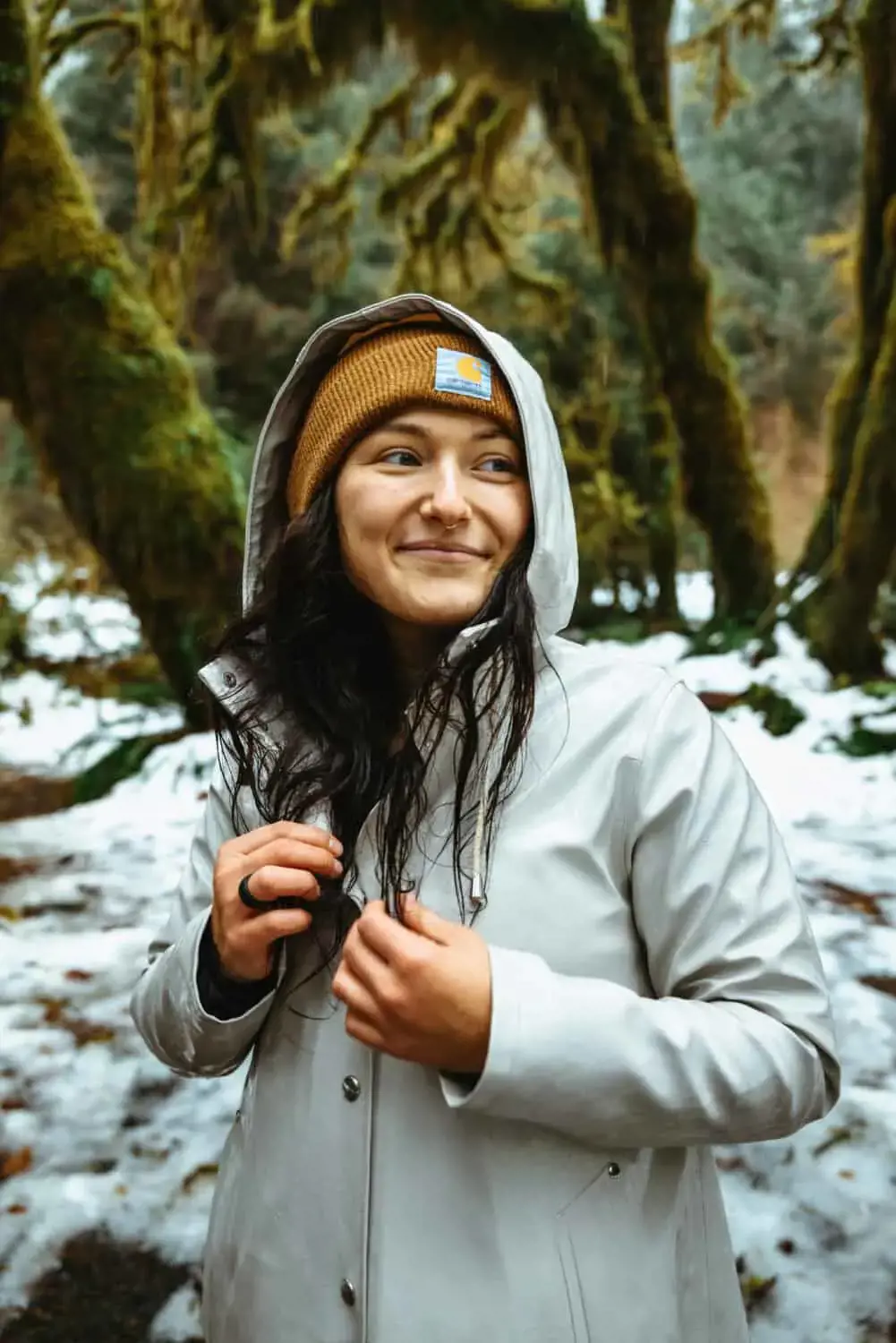
Olympic National Park, located in the state of Washington, offers stunning natural beauty and diverse ecosystems. As with any outdoor adventure, it is important to be prepared for the changing weather conditions. The fall season in Olympic National Park can bring a mix of sunny days, rain showers, and chilly temperatures. Packing the right clothing is key to staying comfortable and enjoying your time in the park.
Layering is the key to dressing appropriately for the ever-changing weather in Olympic National Park during the fall. Here are the essential clothing items to consider packing:
- Base Layers: Start with a good moisture-wicking base layer, such as a lightweight long-sleeve shirt and leggings. This is important as it will help regulate your body temperature and keep you dry from sweat or light rain.
- Mid Layers: Depending on the weather forecast, pack a variety of mid layers such as a fleece jacket or a lightweight down jacket. These layers provide insulation and can be easily added or removed as needed.
- Outer Layers: A waterproof and windproof jacket is essential for protection against rain and gusty winds. Look for a jacket with a breathable fabric to prevent overheating during physical activities.
- Pants: Pack a versatile pair of pants, such as lightweight hiking pants or convertible pants that can be transformed into shorts if the weather turns warmer. Opt for quick-drying materials to stay comfortable during rain showers or if you encounter wet trails.
- Hat and Gloves: Don't forget to pack a warm hat and gloves, as the temperatures can drop significantly, especially during the evenings and early mornings. A beanie and waterproof gloves are great options to keep your head and hands warm.
- Footwear: Choose sturdy and waterproof hiking boots or shoes with good traction. This will provide stability and protection on uneven trails and keep your feet dry in case of rain or wet conditions.
- Accessories: Sunglasses, sunscreen, and a lightweight backpack are essential accessories to bring along. Sunglasses will protect your eyes from the sun's glare, sunscreen will protect your skin from harmful UV rays even on cloudy days, and a backpack will help you carry essential items during your hikes.
It's important to note that the weather in Olympic National Park during the fall can be unpredictable, so it's always a good idea to check the forecast before your trip. Additionally, packing extra layers and clothing options will ensure that you are prepared for any weather changes that may occur.
In conclusion, dressing in layers is the best approach when visiting Olympic National Park during the fall. By having a base layer, mid layers, and an outer layer, you can easily adapt to the changing weather conditions. Don't forget to bring hats, gloves, waterproof footwear, and essential accessories to stay comfortable and enjoy your time exploring the beauty of Olympic National Park.
Essential Items to Pack for a Gymnastics Camp
You may want to see also

Are there any specific hiking gear or equipment I should pack for exploring Olympic National Park in the fall?
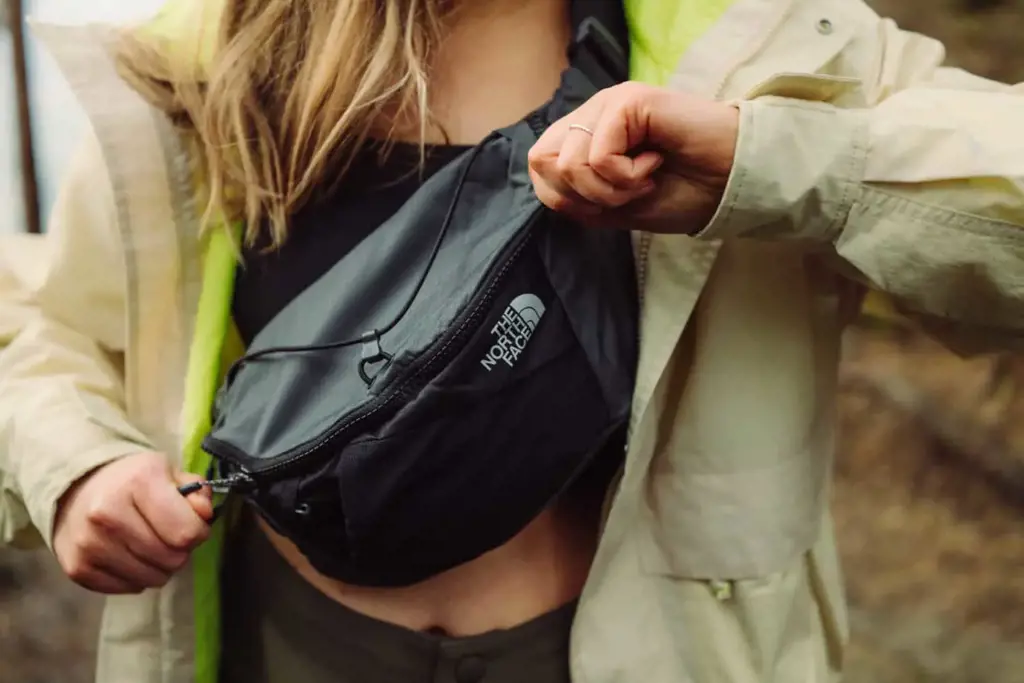
As you plan your adventure to explore the stunning landscapes of Olympic National Park in the fall, it's essential to pack the right gear and equipment to ensure your safety and comfort. The park, located in Washington state, encompasses a diverse range of ecosystems, from temperate rainforests to snow-capped mountains, making it crucial to be prepared for various weather conditions. Here are some specific items you should include in your packing list for a successful and enjoyable fall hiking experience.
- Layered Clothing: Fall weather in Olympic National Park can be unpredictable, with temperature variations throughout the day. It's recommended to wear multiple layers of clothing to easily adjust to changing weather conditions. Start with a moisture-wicking base layer to keep sweat away from your skin, add a insulating middle layer for warmth, and finish with a waterproof and wind-resistant outer layer to protect against rain and cold winds.
- Waterproof Boots: The park receives abundant rainfall during the fall, so it's important to have waterproof hiking boots to keep your feet dry and comfortable. Opt for sturdy boots with good ankle support and a thick sole for traction on wet and rocky trails.
- Rain Gear: Along with waterproof boots, don't forget to pack a reliable rain jacket and pants. Look for options that are lightweight, breathable, and have sealed seams to prevent water from seeping in. This will enable you to comfortably hike through the park even during heavy rain showers.
- Hiking Poles: Hiking poles can be a valuable asset, especially when navigating steep or slippery terrain. They provide stability and aid in maintaining your balance, reducing the stress on your knees and improving your overall hiking experience. Adjustable poles are recommended, as they allow you to tailor the height to your preference and the changing terrain.
- Navigation Tools: Olympic National Park offers a vast network of trails, and it's easy to get disoriented, particularly during periods of low visibility. Carry a detailed topographic map or a GPS device to help you navigate through the park's wilderness. Make sure to familiarize yourself with the route before setting out and always stay on designated trails.
- First Aid Kit: Accidents and injuries can happen while hiking, so having a well-stocked first aid kit is essential. Include items such as bandages, adhesive tape, antiseptic wipes, pain relievers, blister treatments, and any necessary prescription medications. It's also crucial to know basic first aid skills and how to handle emergency situations.
- Food and Water: Pack enough food and water to sustain yourself while on the trail. Consider lightweight and non-perishable options like energy bars, trail mix, and dehydrated meals. It's also a good idea to carry a water filter or purification tablets to access water from natural sources.
- Sun Protection: Even during the fall, it's important to protect your skin from the sun's harmful rays. Pack a broad-brimmed hat, sunglasses, and sunscreen with a high SPF. The reflection of the sun off snow or water can intensify UV exposure, so be particularly cautious when hiking near these environments.
- Backpack: Choose a backpack that is comfortable and fits well, distributing the load evenly on your shoulders and hips. It should have enough capacity to carry all your gear, including extra clothing layers, food, water, and other essentials. Look for a backpack with multiple compartments to help you stay organized.
- Emergency Essentials: Finally, be prepared for unforeseen circumstances by packing some emergency essentials. These may include a lightweight emergency blanket, a whistle, a flashlight with extra batteries, a multi-tool, a fire starter, and a fully charged mobile phone for emergencies.
By packing the right gear and equipment, you'll be equipped to explore the breathtaking landscapes of Olympic National Park in the fall while staying safe and comfortable. Remember to check the weather forecast before your hike and let someone know your itinerary and expected return time. With proper preparation, you can have an incredible adventure and create unforgettable memories in this beautiful national park.
The Essential Items to Pack for a Night Away
You may want to see also

What type of footwear is recommended for hiking on the trails in Olympic National Park during the fall season?
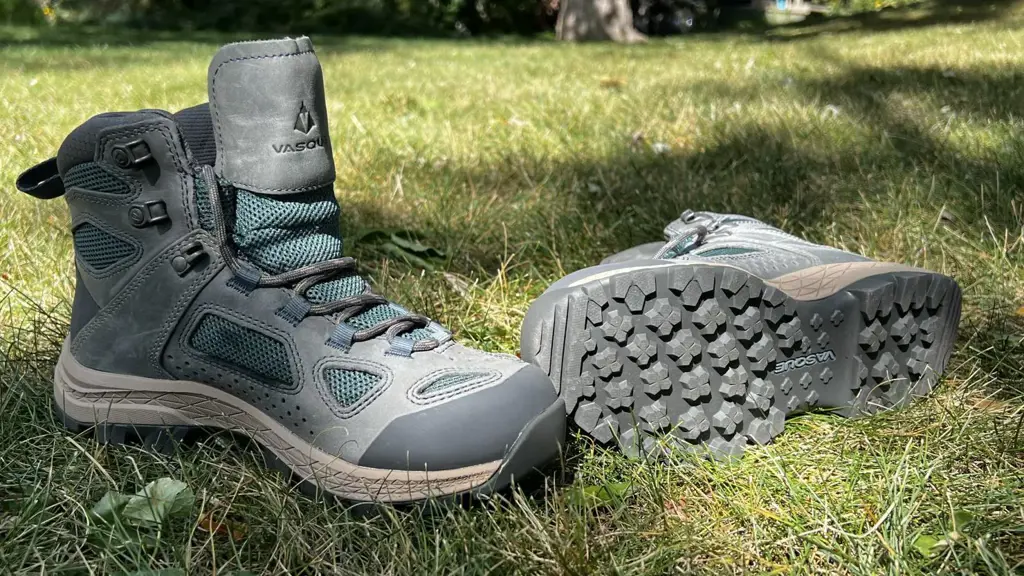
When it comes to hiking in Olympic National Park during the fall season, choosing the right footwear is crucial. The park offers a diverse range of trails, from easy walks to challenging hikes, and the terrain can vary greatly. To ensure your safety and comfort, it is important to select footwear that is suitable for the conditions you may encounter.
One of the most commonly recommended types of footwear for hiking in Olympic National Park during the fall season is a sturdy pair of hiking boots. These boots are designed to provide support and protection for your feet and ankles, which is essential when navigating uneven terrain. Look for boots with good ankle support, a durable outsole for traction, and a waterproof or water-resistant upper to keep your feet dry in wet conditions.
If you prefer something lighter and more flexible than hiking boots, trail running shoes can be a suitable option for some of the park's easier trails. These shoes offer a good balance between support and flexibility, allowing you to move quickly and comfortably. However, keep in mind that they may not provide the same level of ankle support and protection as hiking boots, so they may not be suitable for more challenging hikes or when carrying a heavy backpack.
Regardless of whether you choose hiking boots or trail running shoes, it is important to ensure a proper fit. Ill-fitting footwear can cause blisters, discomfort, and even foot injuries. When trying on hiking boots or trail running shoes, make sure there is enough room in the toe box for your toes to wiggle, but not so much that your foot slides around. It is also a good idea to wear the type of socks you would typically wear while hiking to ensure an accurate fit.
In terms of socks, opt for moisture-wicking or wool socks to help keep your feet dry and prevent blisters. Avoid cotton socks, as they tend to retain moisture and can lead to discomfort and blisters. A sock liner can also be beneficial in reducing friction and preventing blisters, especially on longer hikes.
Finally, it is always a good idea to break in your hiking footwear before embarking on a long hike. Wearing your new boots or shoes for shorter walks or hikes leading up to your trip will allow your feet to adjust to the footwear and can help prevent blisters and discomfort on longer hikes.
In conclusion, when hiking on the trails in Olympic National Park during the fall season, it is recommended to wear sturdy hiking boots or trail running shoes that provide proper support and protection. Remember to choose socks that wick moisture away from your feet to prevent blisters, and always ensure a proper fit. By selecting the right footwear and taking care of your feet, you can enjoy the beautiful trails of Olympic National Park with comfort and confidence.
Essential Packing Guide for Exploring the Holy Lands
You may want to see also

Are there any specific items or gear that are must-haves for photography enthusiasts visiting Olympic National Park in the fall?
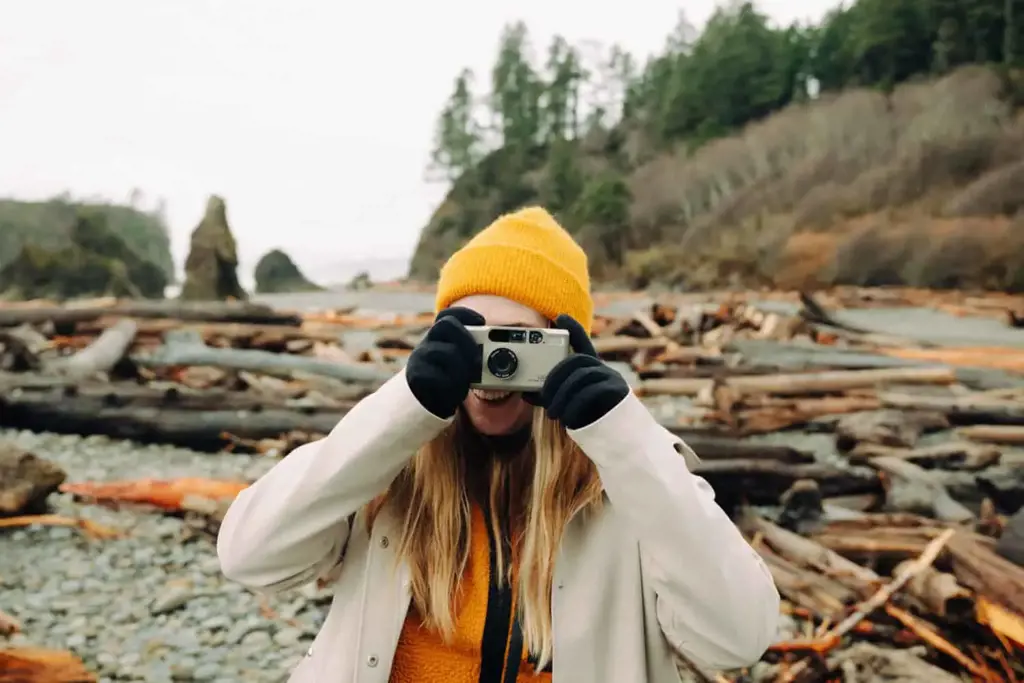
Are you planning a visit to Olympic National Park in the fall? As a photographer, you're in for a treat! This season offers stunning colors and unique opportunities for capturing the beauty of nature. To make the most of your trip, there are a few essential items and gear that you should consider bringing along. Let's dive in and explore what you need to have for a successful photography adventure in Olympic National Park during the fall.
Camera Equipment:
First and foremost, you'll need a reliable camera to capture the breathtaking scenes of Olympic National Park. Whether you prefer a DSLR, mirrorless, or even a smartphone camera, make sure it's something you're comfortable using. A wide-angle lens can be particularly useful for capturing expansive views of the park, while a telephoto lens can help you zoom in on wildlife or details in the landscape. Additionally, don't forget to bring extra batteries, memory cards, and a sturdy tripod to ensure you have plenty of power and stability for your shots.
Filters:
Filters can significantly enhance the quality of your photographs, especially during the fall season. A circular polarizing filter can help reduce glare and increase color saturation, making the vibrant foliage pop even more. Neutral density filters are also handy for controlling the amount of light entering your lens, allowing you to capture long exposure shots of waterfalls or create dreamy motion blur effects.
Tripod:
A tripod is a must-have item for any landscape photographer. It provides stability and eliminates camera shake, ensuring sharp and high-quality images. During the fall season, you might encounter low-light situations or want to experiment with long exposures. In these cases, a tripod becomes even more critical. Look for a sturdy and lightweight tripod that can withstand the elements and allow you to easily adjust the height and angle of your camera.
Weather Protection:
Olympic National Park is known for its diverse weather conditions, so it's crucial to protect your equipment from rain, snow, or moisture. A durable camera bag or backpack with proper padding and waterproofing capabilities is essential. Additionally, consider carrying a rain cover for your camera and lens to shield them from the elements while still allowing you to operate the controls and see through the viewfinder.
Clothing and Footwear:
Fall weather can be unpredictable, so dress in layers to ensure your comfort throughout the day. The temperature can vary significantly between morning and afternoon, so having a combination of warm insulation and moisture-wicking fabrics is essential. Additionally, comfortable waterproof hiking boots are crucial for navigating the park's trails, especially if you plan to explore waterfalls, lakes, or rainforest areas.
Plan and Research:
Before you arrive at Olympic National Park, spend some time researching the park's various photography locations and must-visit spots during the fall season. Familiarize yourself with popular viewpoints, hiking trails, and scenic drives. Look for online resources, join photography forums, or consult guidebooks to gather information and get inspiration for your own shots. By planning ahead, you'll have a better idea of what to expect and can maximize your time in the park.
In conclusion, visiting Olympic National Park in the fall as a photography enthusiast is an excellent choice. By bringing the right camera equipment, filters, tripod, weather protection gear, and appropriate clothing, you'll be well-prepared to capture the park's stunning beauty. Don't forget to plan ahead and research the best photography locations beforehand. With these essentials in your backpack, get ready to capture breathtaking images that will make your friends and family envious of your trip to Olympic National Park in the fall!
Packing Essentials for a September Trip to Kauai
You may want to see also
Frequently asked questions
The weather in Olympic National Park can be unpredictable in the fall, so it's a good idea to pack layers. Be sure to include a waterproof jacket or raincoat, as well as warmer layers like sweaters or fleece jackets. Don't forget to pack comfortable hiking shoes or boots, as there are many beautiful trails to explore in the park.
If you're planning on camping in Olympic National Park in the fall, it's important to pack a good quality sleeping bag that will keep you warm during cold nights. You should also bring a tent that is suitable for cooler temperatures and rain. Additionally, packing a portable camp stove and warm blankets can help make your camping experience more comfortable.
While it's not necessary to bring any specialized equipment for wildlife viewing, it can enhance your experience. Binoculars are a great item to have in order to get a closer look at the various species that call Olympic National Park home. A camera with a telephoto lens is also a good idea for capturing stunning photos of wildlife from a safe distance.
When preparing for hiking in Olympic National Park in the fall, it's important to pack the essentials. This includes a sturdy backpack, plenty of water, snacks, a map or GPS device, and a first aid kit. Additionally, it's a good idea to pack a hat, sunglasses, and sunscreen to protect yourself from the sun, as well as bug repellent to ward off any pesky insects.
If you plan on visiting the coastal areas of Olympic National Park in the fall, it's important to be prepared for changing weather conditions. Be sure to pack a waterproof and windproof jacket, as well as warm layers to protect against cooler temperatures. It's also a good idea to bring waterproof shoes or boots for exploring tide pools and rocky shorelines. Don't forget to pack a camera to capture the stunning scenery and wildlife along the coast.


